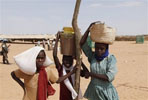
This piece originally appeared in Al Majalla, a leading foreign affairs magazine in the Arab world.
The government of Sudan is moving forward with a new strategy for Darfur that prioritizes nationalization, returns, development and reduced international involvement. While the strategy has some elements that are noteworthy, there is little chance that it will bring peace and stability to Darfur for two reasons: one, because it is not built on a realistic vision of the current state of Darfur; and two, because its core function is to mask the government’s true intentions for the region.
As the world turns its attention to the January referendum that will likely split Sudan into two separate states, recent developments in Darfur have gone virtually unnoticed. Perhaps of greatest concern is the government’s new strategy for the region, which, while seemingly innocuous on the surface, appears to have at its core more nefarious plans for the continuation of massive human rights violations in the region. Diplomats currently engaged in Sudan would therefore be wise to turn a more critical eye to the plan, and ensure that, in their desire to see a peaceful referendum, they do not abandon the people of Darfur.
On 16 September of this year, the government of Sudan officially ratified its “New Strategy for Darfur,” whose objective is supposedly, “to achieve [a] comprehensive and peaceful settlement that restores[s] life in Darfur and enable[s] efforts for development in the area.” The strategy focuses on four key themes. First, it de-emphasizes the internationally-guided peace process in Doha, calling instead for a “nationalized” process with the National Congress Party (NCP) at the helm. Second, it places a tremendous amount of emphasis on the “safe, voluntary, and sustainable” return of the displaced to their places of origin, and calls on the international community to assist in this process. Third, the strategy calls for a shift in focus from relief to development, which it ties to returns in suggesting that the provision of services would be centered around villages of origin. Finally, the strategy outlines a diminished role for the international community, with intervention areas being limited to promoting security, paying compensation, and contributing to development and returns. Most importantly, it calls on the international community to engage more “constructively” in Darfur by halting the spread of “false information” and by abandoning the International Criminal Court case against President Omar Al-Bashir.
Although there are some elements of the strategy that sound encouraging, such as the government’s recognition of the need for development in the region, the strategy is inherently flawed due to its failure to reflect the reality of the situation on the ground. Many of the people of Darfur have once been or continue to be victims of crimes perpetrated by the government itself. Given their history, it is difficult to imagine that the NCP, as one of the key perpetrators, would work to produce a deal that truly represents the interests of all parties to the conflict. Even if the government were planning to negotiate in earnest, which is unlikely, the mistrust that exists among the parties would prevent a deal from ever holding.
Even more troubling, however, is the notion that returns are possible in the current environment and that they should be encouraged.
Click here to continue reading.
Photo: Children at an IDP camp in Darfur (AP)

